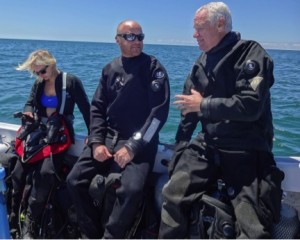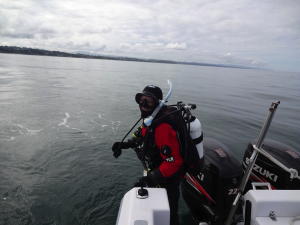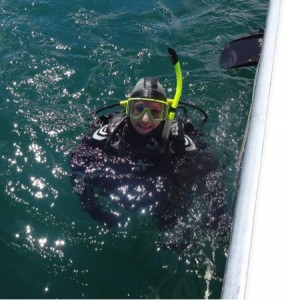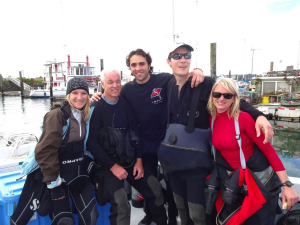
In an effort to document changes in Northwest rockfish populations, Oregon Coast Aquarium has collaborated with the Seattle Aquarium and Point Defiance Zoo to survey rockfish populations in the Pacific Northwest. I was eager to participate in this project, not only because it would allow me to work on my videography skills, but also because I would have the chance to dive with a full-face mask. There are a number of advantages to diving with a full face mask, including limiting exposure to cold temperatures or contaminated waters, as well as allowing you to communicate underwater through either hardwire or wireless communication devices. This project takes advantage of underwater communication to improve the accuracy of the surveys by combining in-situ audio data with a visual recording of the test site.
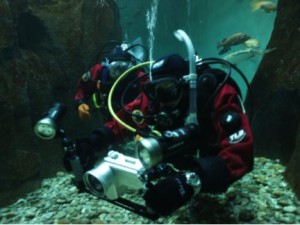
training in Halibut Flats
The first step was getting trained for diving a full-face mask configuration. Along with seven other scientific divers from the aquarium I settled into the conference room for the classroom portion of the training. Any time you are diving with new equipment it is important to understand how that piece of equipment works and the risks associated with it. By having both a knowledge and skill based appreciation for your dive gear, you will be better prepared to react to situations that may arise. After learning about the background/ methodology of the project and going over the specifics of diving with a full-face mask, it was time for some in water training in Passages of the Deep. The first group of divers geared up, adjusted the masks in order to get a good seal, and got in the shark observation pool, a small enclosure connected to Open Sea (the exhibit holding the sharks and rays), which is used for feeding the rays and introducing new animals.
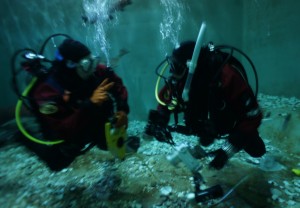
This was an ideal place to get familiar with using a full face mask because it is shallow, only 12 feet deep, and the water temperature is slightly warmer than Halibut Flats. Unfortunately when it came time for me to try out the masks, my face was too small to get a good seal. Vallorie assured me however that I would still be able to work on the project wearing a conventional mask. Once the rest of the crew were comfortable with removing and replacing their masks, we got into Halibut Flats to practice setting up transects and using the video camera.
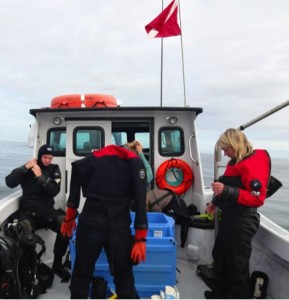 A few days later it was time to try out our new skills in open water. Jim, Vallorie, myself and four other AAUS Scientific Divers set out on Gracie Lynn for North Reef, which was selected as one of the survey sites for the rockfish project. The first buddy team went down to place the block that we would start the survey from. Once they had it in place, they signaled their location by deploying a surface marker buoy, which cued Vallorie and I to get inthe water. We descended along the anchor line and pointed our compasses towards the heading we had taken on the surface. The visibility was only about 5 ft. but within a few minutes we were able to locate the other buddy pair waiting by the block. I clipped the transect tape to the block and we swam south along the wall to conduct the survey. Visibility was poor and the current made it a challenge to remain in proper positioning with Vallorie, but we made it to 50 meters, at which point I signaled to Vallorie that it was time to turn around. On the way back towards the block, the camera housing started beeping, signaling that a leak was detected. We quickly got back to the marker buoy and ascended to care for the camera. Once on board we washed the housing with fresh water and carefully took it apart. This should be the first step any time you suspect a leak in your underwater camera housing. We then placed the camera in a zip lock bag with desiccant pellets in hopes that it would dry out before any damage was done. We were unable to use the camera the rest of the day, but luckily this was just a training day and it was not critical that we collect data. We spent the rest of the dives working on skills such as navigation, setting up transects, and deploying surface marker buoys, and also had the chance to collect invertebrates for the aquarium. Although some may consider the low visibility, high surge water to be less than ideal diving conditions, I feel that the difficult working conditions enhance training dives. If you can successfully handle equipment and manage task loading in these conditions, you will be much better prepared for future dives no matter where they are!
A few days later it was time to try out our new skills in open water. Jim, Vallorie, myself and four other AAUS Scientific Divers set out on Gracie Lynn for North Reef, which was selected as one of the survey sites for the rockfish project. The first buddy team went down to place the block that we would start the survey from. Once they had it in place, they signaled their location by deploying a surface marker buoy, which cued Vallorie and I to get inthe water. We descended along the anchor line and pointed our compasses towards the heading we had taken on the surface. The visibility was only about 5 ft. but within a few minutes we were able to locate the other buddy pair waiting by the block. I clipped the transect tape to the block and we swam south along the wall to conduct the survey. Visibility was poor and the current made it a challenge to remain in proper positioning with Vallorie, but we made it to 50 meters, at which point I signaled to Vallorie that it was time to turn around. On the way back towards the block, the camera housing started beeping, signaling that a leak was detected. We quickly got back to the marker buoy and ascended to care for the camera. Once on board we washed the housing with fresh water and carefully took it apart. This should be the first step any time you suspect a leak in your underwater camera housing. We then placed the camera in a zip lock bag with desiccant pellets in hopes that it would dry out before any damage was done. We were unable to use the camera the rest of the day, but luckily this was just a training day and it was not critical that we collect data. We spent the rest of the dives working on skills such as navigation, setting up transects, and deploying surface marker buoys, and also had the chance to collect invertebrates for the aquarium. Although some may consider the low visibility, high surge water to be less than ideal diving conditions, I feel that the difficult working conditions enhance training dives. If you can successfully handle equipment and manage task loading in these conditions, you will be much better prepared for future dives no matter where they are!
